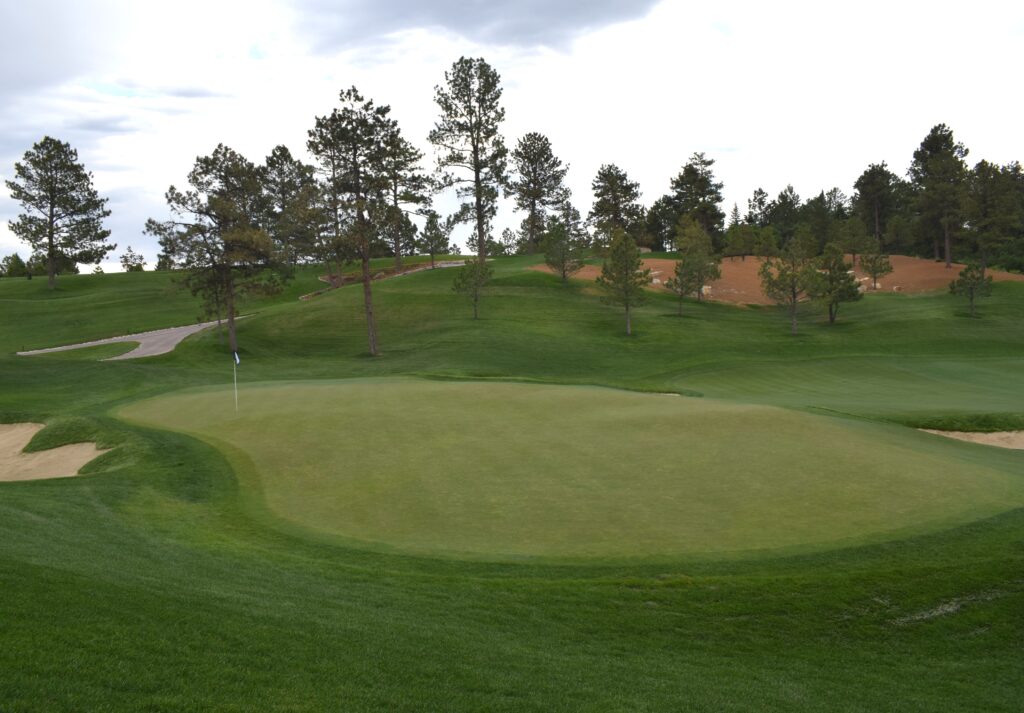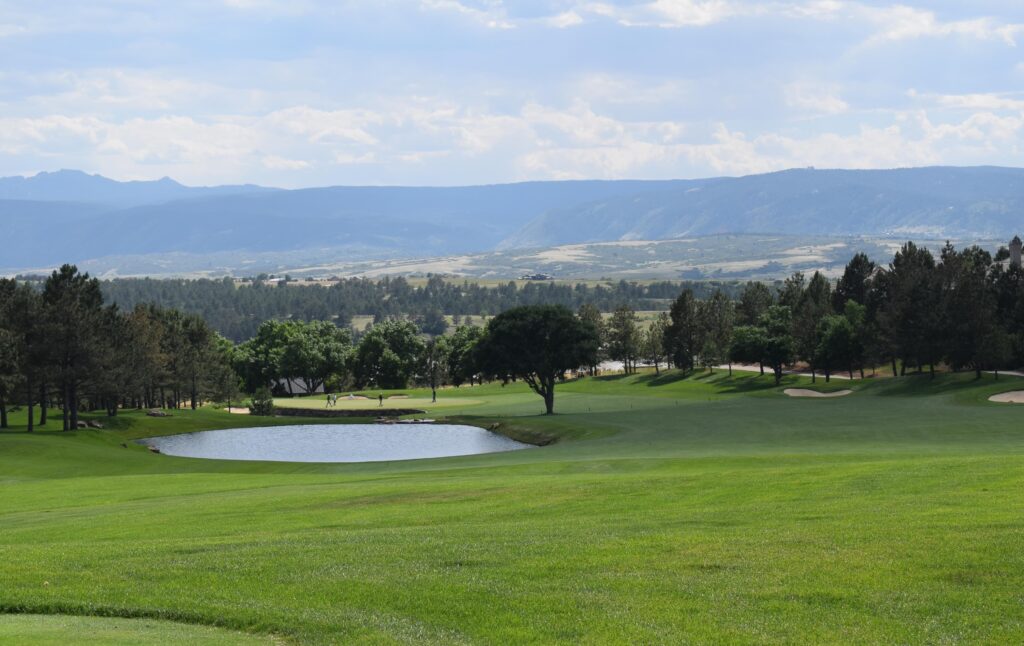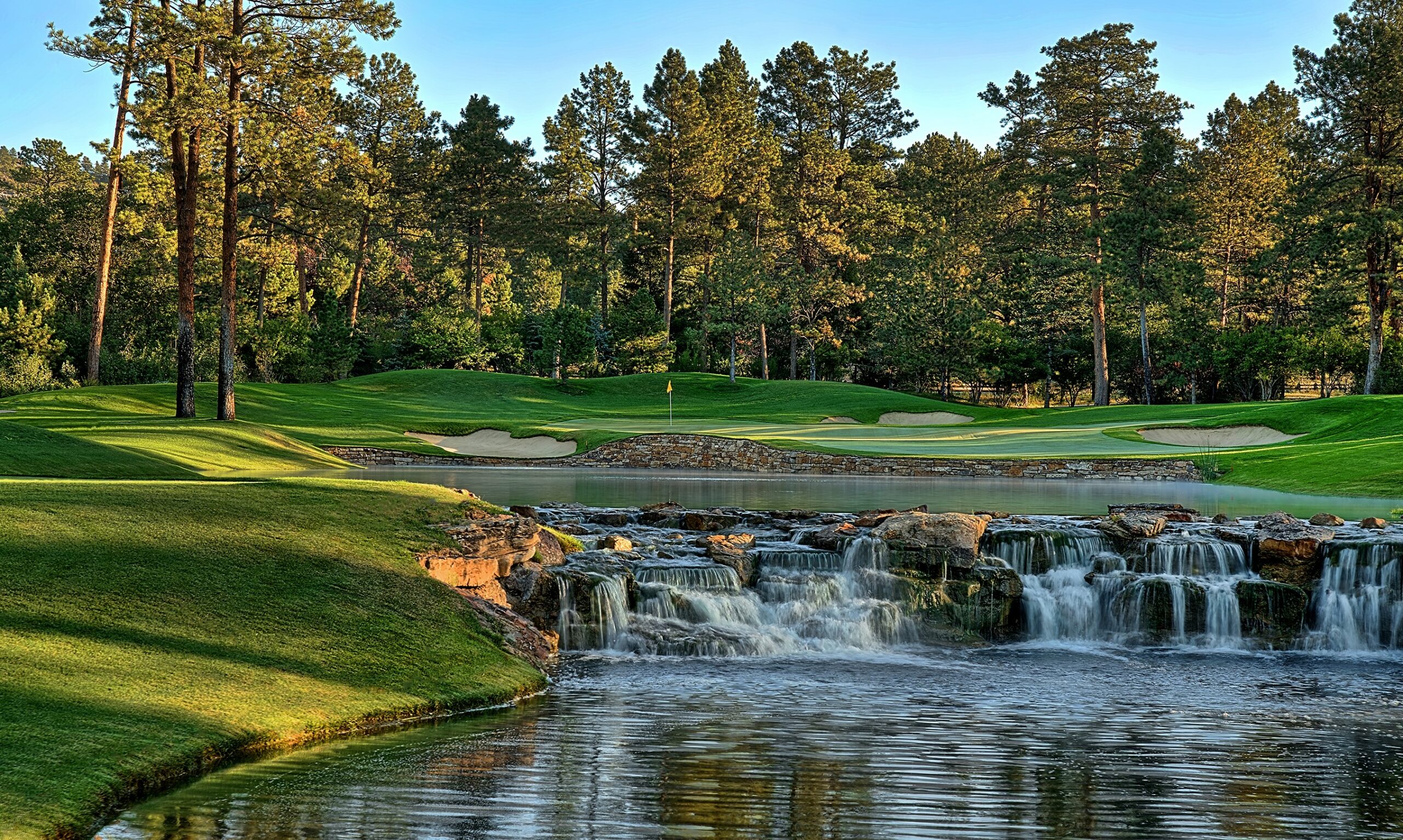Much has changed at Castle Pines Golf Club since The International days, including several major course alterations; at 8,130 yards for this week’s BMW Championship, it’ll be longest course setup for a PGA Tour event since at least 1983
By Gary Baines – 8/19/2024
In a recent discussion in which he noted how far Denver native Wyndham Clark was hitting certain clubs at Castle Pines Golf Club, PGA general manager Keith Schneider, who has worked at the course for 43 years, may have summed it up best.
“You can’t make a golf course long enough for these guys,” he said.
By “these guys”, Schneider meant top-level PGA Tour players.
The folks at Castle Pines, where the PGA Tour’s International was held for 21 years (1986-2006), realize what Schneider says is true, particularly at a course in the thin air more than 6,000 feet above sea level. Still, course length is one way to add to the test of a FedExCup Playoff event.
So, as first reported here last October, the length at which Castle Pines will be set up for this week’s BMW Championship (8,130 yards) will make it the longest course utilized on the PGA Tour since at least 1983, when such distances began being routinely recorded. The current record is 7,876 yards for the 2021 PGA Championship, held at the Ocean Course at Kiawah Island, S.C.
But given the altitude at Castle Pines — where the course’s highest point is 6,400 feet above sea level — the effective yardage at the BMW Championship will be pretty ordinary by PGA Tour standards, as most players will hit the ball 10 or 15 percent further than they do at sea level.
“It could be anywhere from a 10 percent to a 20 percent increase in yardage with the altitude out here, depending on the time of day, weather conditions, etc.,” said Vince Pellegrino, the senior vice president for tournaments for the Western Golf Association, which oversees the BMW Championship. “You take an 8,200-yard golf course, it’s probably playing right where they play week-in and week-out on the PGA Tour. We want to make sure it’s a really tough, fair test of golf for the best players in the world. Playing it at 8,200 and at a par-72 … You also have to remember, this is entertainment. We like to see birdies, we like to see eagles. The fans appreciate that. It’s a tough golf course, and regardless, the cream will rise to the top this week.”
Many golf fans — particularly in Colorado — may have become familiar with the PGA Tour setup at Castle Pines during The International days, either by attending the tournament in person or watching it on TV. But it has been tweaked quite a bit since then by Jack Nicklaus, who originally designed Castle Pines, which opened in 1981.
Nicklaus reworked the course from 2015-2023, according to Schneider, and visited the club personally roughly 10 times over that period.
“These were all his changes,” Schneider said.
Every hole was affected in one way or another as greens, tees, bunkers and water features were rebuilt, and many fairways were narrowed in projected PGA Tour landing areas. Plus, an all new irrigation system was installed. And new turf bordering fairways and greens — roughly 12 feet throughout — has been replaced at the PGA Tour’s request as grass strains such as Bent, Poa and others had infiltrated the Kentucky Bluegrass, which tournament officials want to be quite thick in the intermediate and regular rough.

The relocated eighth green at Castle Pines GC bears almost no resemblance to the one from The International days.
It will take a discerning eye to catch many of the changes at Castle Pines, but some will be readily apparent to those who remember the course from The International days. The biggest alterations visually are on the par-5 eighth hole, where the green was moved substantially, and the second, third, fifth and 16th holes, where other major changes were made.
The work that’s been done will allow Castle Pines to be set up more than 500 yards longer than it was for The International, where a typical yardage was 7,559 for the par-72 layout.
“We’ve continued to refine the golf course for the modern game,” said George Solich, the chairman and president of CPGC. “We’ve reshaped this golf course completely. What I like to say is we started with a Picasso, and we just made that Picasso better. We couldn’t have done it without Jack Nicklaus. He’s been here a couple of times a year for literally the last eight years straight. He takes great pride in what we’ve collectively created here at Castle Pines.
“The improvements — paired with our passion for excellence, quality at every turn and a unique and warm and welcoming service — ensure we are ready to once again host the best players on the PGA Tour.”
There have also been other major upgrades at Castle Pines (including to the clubhouse and the cottages) or outright additions (such as a caddie house, transportation building, a teaching pavilion and a range support building).
“We’ve hit every square inch of our infrastructure,” Schneider noted.
With the help of Schneider — who started at Castle Pines GC as a PGA head professional in 1981 and is now the PGA general manager there — and current CPGC PGA head professional Drew Parr, here are some of the notable changes Castle Pines Golf Club has undergone over the last decade, hole by hole. (Note: Schneider, a Colorado Golf Hall of Fame inductee, will retire later this year. The club’s leadership has awarded him a lifetime honorary membership at CPGC.)
Hole 1 (Par 5) — Yardage increase from days of The International: 644 yards to 662. Notable Changes: No major changes on this picturesque downhill slight dogleg left other than the yardage, the addition of a right fairway bunker and the narrowing the fairway somewhat in the likely driving area for PGA Tour players.
Hole 2 (Par 4) — Yardage increase from days of The International: 408 yards to 440. Notable Changes: This dogleg right has been altered quite a bit from The International days. Previously, there was a dry gulch/waste bunker that cut through the hole, going from the left of the fairway to the back of the green. A third of that was filled in, with a pond being added in front and right of the green. Also, a small pot bunker was created in front of the putting surface.

The third hole looks dramatically different than it was for The International.
Hole 3 (Par 4) — Yardage increase from days of The International: 462 yards to 477. Notable Changes: Like hole 2, this was a significant change from during the time of The International. After previously having two sets of tees and a double fairway with a large gulch going through the west-bound hole, now there’s just a single Tour teebox area, the ditch has been filled in and two ponds were added to the left side, going up to the green.
Hole 4 (Par 3) — Yardage increase from days of The International: 205 yards to 254. Notable Changes: In addition to the substantial yardage increase, a large right front bunker from The International days has been made into two now. And two tees have been added to the left of the gulch to the pre-existing one on the right of the gulch.
Hole 5 (Par 4) — Yardage increase from days of The International: 477 yards to 491. Notable Changes: The fairway on this slight dogleg right has been shrunk, with the now-deepened fairway bunkers tightening the landing area. Around the green, a collection bunker was removed and two greenside bunkers were added. The angle of the green itself has been altered since The International. Behind the back left of the green, fairway-cut grass has been put in place. A transitional bunker about 50 yards from the green — in the middle of the fairway — was also added.
Hole 6 (Par 4) — Yardage increase from days of The International: 417 yards to 455. Notable Changes: New tees, lower than the originals, were added to this down-then-up dogleg right. Bunkering was put in place on the left side of the fairway, with the large bunker on the right being made into two — and deepened. In fact, all the bunkers on the hole were redone, with a collection bunker near the green removed and two greenside bunkers added. A swale was put in place off of the first bunker, preventing a ball that trickles off the front of the green from going all the way down the hill. Putting here will be a challenge, as it was before.
Hole 7 (Par 3) — Yardage increase from days of The International: 185 yards to 207. Notable Changes: The entire tee complex here was rebuilt from the days of The International. Tiger Woods famously made a hole-in-one here in 1988.
Hole 8 (Par 5) — Yardage increase from days of The International: 535 yards to 601. Notable Changes: This hole marks a big-time change from what it was during The International. The Tour tee was rebuilt, but the main change is that the green has been totally moved — 35 yards further from the tee. The old green had a deep grass collection area left of the putting surface and a forest of trees to the right of it. Now the area around the green is much more open. In general, the hole has been straightened somewhat, rather than the green being tucked to the right. The fairway here was also narrowed.
Hole 9 (Par 4) — Yardage increase from days of The International: 458 yards to 495. Notable Changes: All of the water feature that runs up the right side of this uphill dogleg-right par-4 has been rebuilt; it’s now a bit wider and more dramatic. A new tee was added and the fairway was narrowed.
Hole 10 (Par 4) — Yardage increase from days of The International: 485 yards to 545. Notable Changes: Even though the yardage of the downhill dogleg-right hole has “officially” increased by quite a bit since The International, the added length is actually fairly minimal, according to Schneider. “Back when the USGA said a certain yardage had to be a par-5, we fibbed (so it could be a par-4),” he said. All the greenside bunkers have been removed. Still, given the yardage and the water fronting and to the right of the green, this hole can prove formidable.
Hole 11 (Par 3) — Yardage increase from days of The International: 197 yards to 200. Notable Changes: On this big-time downhill par-3, a bunker greenside left replaced three pine trees that were there during some of The International’s run.

The 12th hole at Castle Pines GC is one of the most picturesque. (Courtesy photo)
Hole 12 (Par 4) — Yardage increase from days of The International: 440 yards to 451. Notable Changes: The multitude of flowers and the cascading waterfalls continue to make this par-4 very picturesque leading up to the green. Some additional green has been added to the back left portion, and a pot bunker near that side of the putting surface was put in.
Hole 13 (Par 4) — Yardage increase from days of The International: 439 yards to 486. Notable Changes: A new tee has added almost 50 yards to this slight dogleg right hole since The International.
Hole 14 (Par 5) — Yardage increase from days of The International: 623 yards to 655. Notable Changes: During the early days of The International, a dry creek crossed the fairway about 145 yards from the green. Later, a water feature was added, with a pond fronting the left portion of the green. A new tee added some length to the hole.
Hole 15 (Par 4) — Yardage increase from days of The International: 403 yards to 439. Notable Changes: The dogleg-right hole is similar to before, albeit with some added yardage.
Hole 16 (Par 3) — Yardage increase from days of The International: 209 yards to 226. Notable Changes: “We’ve changed it about five times,” Schneider noted of this par-3. Since The International, a pond with a stone wall has been added just short of the green, with a picturesque mini waterfall closer to the tee. A raised tee complex is now in place. The green is now two-tiered — similar to No. 16 at Augusta National — and may present putting challenges with the surfaces at CPGC running at 13 on the Stimpmeter. The course had fairway-length grass behind the green, but it’s been replaced with regular rough.
Hole 17 (Par 5) — Yardage increase from days of The International: 492 yards to 532. Notable Changes: A new tee on the other side of a lake added 30 yards to this very scoreable dogleg-left par-5. The stream that flows down the hill — toward the tee — just left of the fairway has been enlarged slightly. Bunkers on the right side narrows the fairway in the 300-yard plus zone. A bunker was added to the back left of the green and the other greenside bunkers were deepened a bit. The fairway-length cut behind the green was replaced with rough.
Hole 18 (Par 4) — Yardage increase from days of The International: 480 yards to 514. Notable Changes: A new tee adds 30-plus yardage to this slight dogleg left that has the impressive clubhouse as a backdrop. One bunker was removed from left of the fairway and three were added — about 10 yards into the fairway, considerably narrowing it. The bunkers left of the fairway are very deep and penal. The bunker right of the fairway has been moved toward the green a bit, and a pot bunker was placed near the right front of the green.

An overview of the ninth and 18th greens, the clubhouse and the practice range at Castle Pines Golf Club. (Courtesy photo)
About the Writer: Gary Baines has covered golf in Colorado continuously since 1983. He was a sports writer at the Daily Camera newspaper in Boulder, then the sports editor there, and has written regularly for ColoradoGolf.org since 2009. The University of Colorado Evans Scholar alum was inducted into the Colorado Golf Hall of Fame in 2022. He owns and operates ColoradoGolfJournal.com
**********************************
BMW CHAMPIONSHIP: THE ESSENTIALS
What: The BMW Championship, the second of three PGA Tour FedExCup Playoff events in 2024.
When: Aug. 22-25 championship rounds (Thursday-Sunday). Aug. 20 practice round (Tuesday). Aug. 21 pro-am (Wednesday). Note: Closed to the public on Aug. 19 (Monday). Gates open at 7 a.m. Tuesday through Friday and 6:30 a.m. on Saturday and Sunday.
Where: Castle Pines Golf Club in Castle Rock, opened in 1981 and designed by Jack Nicklaus. Castle Pines GC hosted the PGA Tour’s International from 1986 through 2006. Colorado Sports Hall of Famer Jack Vickers founded Castle Pines GC and The International.
Purse: $20 million, with the winner receiving $4 million.
Beneficiary: All the net proceeds from the BMW Championship benefit the Evans Scholars Foundation for caddies. Evans Scholarships, worth an estimated average of $125,000, are awarded by high-achieving teenage caddies with significant financial need.
Defending Champion: Viktor Hovland.
Course Setup: A PGA Tour-record length (since at least 1983) of 8,130 yards (Par-72). Green speed on Stimpmeter: 13. 77 bunkers and 10 water hazards.
Junior Clinic: 4 p.m. on Aug. 21 (Wednesday).
History of Event in Colorado: The BMW Championship has been held once before in the Centennial State, in 2014 at Cherry Hills Country Club.
Tickets/Military Honors: For information, CLICK HERE. Note: Kids 15 and under receive complimentary grounds admission when accompanied by a ticketed adult (2 juniors per adult). Also, active-duty military, along with military retirees, active reserves and veterans can also be admitted free to the tournament after obtaining passes at bmwchampionship.com . On Aug. 22 (Thursday), an opening ceremony on the first tee at 8 a.m. will feature singer/songwriter Amanda Hawkins performing the national anthem and a flyover by four F-16 fighter jets from the Colorado Air National Guard. Spectators with military tickets for Tuesday and Wednesday will have access to the Nicklaus Club, a climate-controlled lounge equipped with a PXG golf simulator, complimentary food and drinks and seating overlooking the iconic par-3 16th hole.
Format: 50-player field. No cut. The top 30 in the season-long point standings after the BMW Championship will advance to the Tour Championship.
TV Schedule: Aug. 22 and 23 (Thursday and Friday): noon-5 p.m., Golf Channel; Aug. 24 and 25 (Saturday and Sunday): 11 a.m.-1 p.m., Golf Channel; 1-4 p.m., NBC. Dan Hicks, Kevin Kisner, Terry Gannon and Brad Faxon will call the action at different times from Castle Pines.










